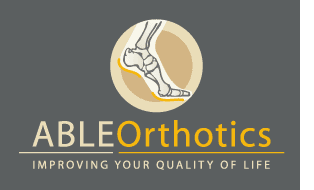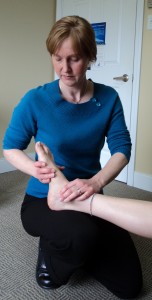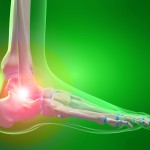Why Your Shoe Choice is so Important
Posted by: ABLE Orthotics on April 21, 2010
Wow, selecting new shoes can be such an overwhelming task! Choosing shoes based on price, or even simply on looks, can get you in a lot of trouble. Ask me — I’ve seen lots of examples over the years!
Over the course of your lifetime, you will walk over 150,000 miles, so it’s important that your feet are well set up to accommodate you. Shoe choice is an essential part of that. Your choice of shoes will make a big difference as to how active you are able to be and will have a big impact on your quality of life. It can mean the difference of running and or walking in comfort or in pain, how active you are able to be and, most importantly, your ability to stay healthy and injury free.
Often we don’t accurately connect the symptoms or problems we experience with the pain that we feel. You probably remember the children’s chant “the ankle bone connected to the knee bone, knee bone connected to the hip bone, hip bone connected to the back bone..” and so on. While not immediately apparent when you are running, walking or standing, everything rests on your shoes. If your shoes don’t support you properly, that can translate into problems all over the rest of your body.
According to the Canadian Pedorthic Association, “Approximately 20-30 per cent of people experiencing pain or discomfort during an activity, such as a walking or even running program, are unaware that this is caused by improper footwear and can be easily be rectified by finding the right type of shoe. Buying the wrong type of footwear can cause problems ranging from minor discomfort such as blisters, corns and calluses to more serious conditions including repetitive stress injuries to the joints and muscles.” So do yourself a favour and take good care of your feet!
Here at ABLE Orthotics, shoe sales are not a big part of our business, but we care about your feet! So if you come and see us we probably won’t sell you shoes. The shoes we do sell are primarily for specialty cases, or when shoes need to be modified to accommodate a patient’s particular needs.
However, we are experts at ensuring that you know the right type of footwear for your specific lifestyle needs (work and play), for your biomechanical needs, and for any specific problems you may be presenting with. We can help ensure the proper fit and correct support for your foot type. In addition, we would be happy to recommend shoe stores where we know you will be properly fitted.
So remember, while choosing shoes can be an overwhelming task given all the high-tech shoes available today and all the special features each shoe claims to have, keep these things in mind:
- Proper footwear choice and fit is essential in reducing symptoms and may help prevent problems. Every year more than 1.2 million Canadians have a sports related injury that could have been prevented through proper fitting footwear and shoe selection.
- A Pedorthist is trained to evaluate your foot needs and provide you with footwear education that is specific to your foot type and lifestyle needs.
- If you require foot orthoses in your shoes, the footwear must compliment the orthoses to improve the outcome of wearing the orthoses.
When Should You Retire Your Old Shoes?
- A general rule: a shoe worn 80% of the time, should be replaced within 8-12 months.
- Running shoes need to be replaced every 500 miles
Shoes are worn out if:
- the tread has worn off/ become smooth on the bottom of the shoe
- the wear pattern on the bottom of the shoe is excessive/severe
- there are a lot of creases/wrinkles in the sides of the sole
Remember, do yourself a favour and take care of your feet. Not everyone needs to consult with a Pedorthist, but if you are experiencing pain and you think you may have a lower limb or foot problem, talk with your Doctor and they can recommend that you see a Pedorthist. Canadian Certified Pedorthists (C Ped (C)) are one of the few healthcare professionals trained in the assessment of lower limb anatomy and biomechanics, with specialized education and training in the design, manufacture, fit and modification of foot orthotics and footwear.



 If you live long enough, you can count on developing at least some form of arthritis; a touch of osteoarthritis, at the very least. Arthritis affects an estimated 4.2 million Canadians of all ages, with numbers expected to increase by 50% by 2020. And while arthritis is often considered a disease of older people, babies in diapers can get it too, and many people are affected in the prime of their lives. Here at ABLE Orthotics, our focus when dealing with patients with arthritis is to alleviate pain and help people stay as active as possible.
If you live long enough, you can count on developing at least some form of arthritis; a touch of osteoarthritis, at the very least. Arthritis affects an estimated 4.2 million Canadians of all ages, with numbers expected to increase by 50% by 2020. And while arthritis is often considered a disease of older people, babies in diapers can get it too, and many people are affected in the prime of their lives. Here at ABLE Orthotics, our focus when dealing with patients with arthritis is to alleviate pain and help people stay as active as possible. Rheumatoid arthritis is a disease that has yet to be tamed. Although rarely life threatening, it can be tormenting because of the relentless pain. It is not a result of wear-and-tear but rather an auto-immune condition in which the body’s own immune system attacks the joints thinking they are foreign matter; attempting to destroy them. Usually relief for painful joints in the feet or ankles will require custom made shoes and soft inserts to take much of the weight off the diseased metatarsal heads. It is important that a rheumatologist, a specialist well versed in the various diagnostic methods of treatments, treat this disease.
Rheumatoid arthritis is a disease that has yet to be tamed. Although rarely life threatening, it can be tormenting because of the relentless pain. It is not a result of wear-and-tear but rather an auto-immune condition in which the body’s own immune system attacks the joints thinking they are foreign matter; attempting to destroy them. Usually relief for painful joints in the feet or ankles will require custom made shoes and soft inserts to take much of the weight off the diseased metatarsal heads. It is important that a rheumatologist, a specialist well versed in the various diagnostic methods of treatments, treat this disease.